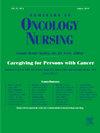The Effect of a Musical Starry Sky Projector on Fatigue, Sleep, and Quality of Life in Pediatric Oncology Patients: A Randomized Controlled Trial
IF 2.3
4区 医学
Q1 NURSING
引用次数: 0
Abstract
Objectives
This study aimed to evaluate the effect of an Ocean Wave and LED Starry Sky Projector on fatigue, sleep, and quality of life (QoL) in pediatric oncology patients.
Methods
This randomized controlled trial included 60 pediatric oncology patients aged 8 to 18 years who were newly diagnosed with cancer and undergoing chemotherapy. Participants were randomly allocated into two groups: intervention (n = 30) and control (n = 30). The intervention group received standard care plus nightly exposure to an Ocean Wave and LED Starry Sky Projector for 30 minutes before sleep, over a period of 1 week. The control group received standard care only. Data were collected using the Adolescent Information Form, Pediatric Quality of Life Scale, Visual Sleep Scale, and Fatigue Intensity Scale. Fatigue and sleep quality were assessed daily, while QoL was evaluated on the first and seventh days.
Results
The descriptive characteristics of children in the intervention and control groups were found to be homogeneously distributed. Although no statistically significant difference was observed in sleep quality between the groups on the first day (P > .05), significant differences favoring the intervention group were found from the second to the seventh day (P < .05). Similarly, no significant differences were found in fatigue levels between the two groups throughout the week (P > .05). There was no statistically significant difference in the mean scores of the “Pediatric Quality of Life Scale” between the groups (P > .05).
Conclusions
This study found that the ocean wave and LED starry sky projector significantly improved sleep quality over time in pediatric oncology patients but had no significant effect on fatigue or QoL.
Implications for Nursing Practice
Nurses can use musical projectors as a noninvasive, cost-effective tool to improve sleep quality in pediatric oncology patients during treatment.
音乐星空投影仪对儿童肿瘤患者疲劳、睡眠和生活质量的影响:一项随机对照试验。
目的:本研究旨在评估海浪和LED星空投影仪对儿科肿瘤患者疲劳、睡眠和生活质量的影响。方法:本随机对照试验纳入60例8 ~ 18岁新诊断为癌症并正在接受化疗的儿科肿瘤患者。参与者被随机分为两组:干预组(n = 30)和对照组(n = 30)。干预组接受标准护理,每晚睡前暴露在海浪和LED星空投影仪下30分钟,持续一周。对照组仅接受标准治疗。数据采用青少年信息表、儿童生活质量量表、视觉睡眠量表和疲劳强度量表收集。每天评估疲劳和睡眠质量,在第1天和第7天评估生活质量。结果:干预组和对照组患儿的描述性特征均呈均匀分布。第1天各组睡眠质量差异无统计学意义(P < 0.05),第2天至第7天干预组睡眠质量差异有统计学意义(P < 0.05)。同样,两组在一周内的疲劳程度也没有显著差异(P < 0.05)。两组患儿“儿童生活质量量表”平均得分比较,差异无统计学意义(P < 0.05)。结论:本研究发现,随着时间的推移,海浪和LED星空投影仪显著改善了儿科肿瘤患者的睡眠质量,但对疲劳和生活质量没有显著影响。对护理实践的启示:护士可以使用音乐投影仪作为一种无创的、经济有效的工具来改善儿科肿瘤患者治疗期间的睡眠质量。
本文章由计算机程序翻译,如有差异,请以英文原文为准。
求助全文
约1分钟内获得全文
求助全文
来源期刊

Seminars in Oncology Nursing
Nursing-Oncology (nursing)
CiteScore
3.40
自引率
0.00%
发文量
68
审稿时长
45 days
期刊介绍:
Seminars in Oncology Nursing is a unique international journal published six times a year. Each issue offers a multi-faceted overview of a single cancer topic from a selection of expert review articles and disseminates oncology nursing research relevant to patient care, nursing education, management, and policy development.
 求助内容:
求助内容: 应助结果提醒方式:
应助结果提醒方式:


